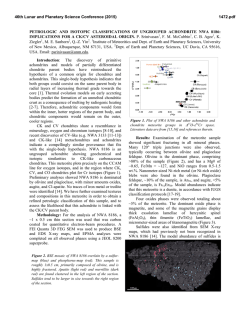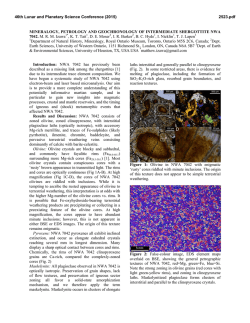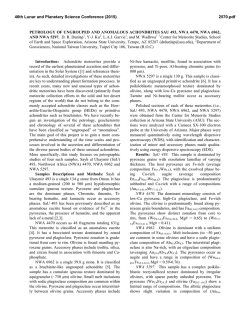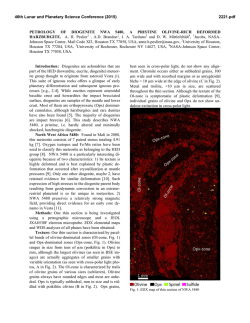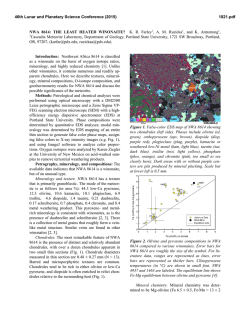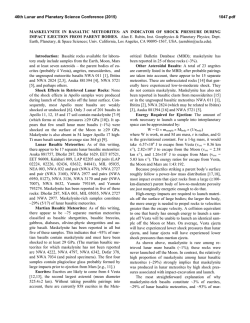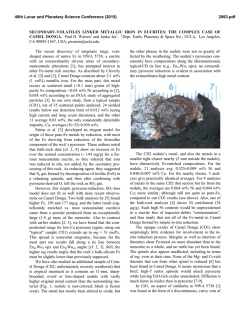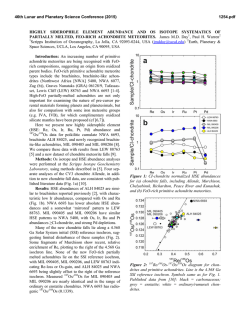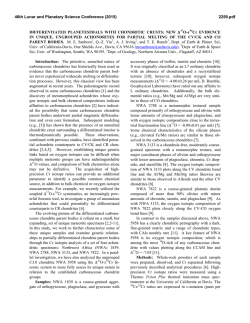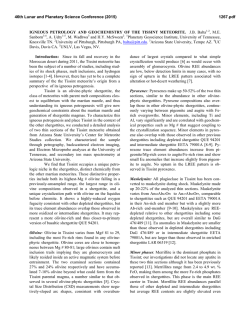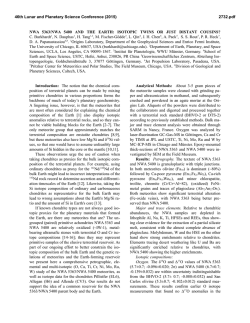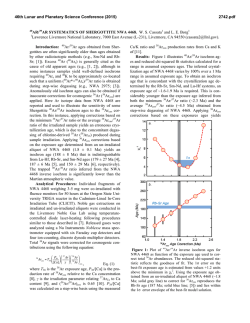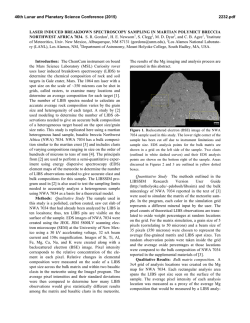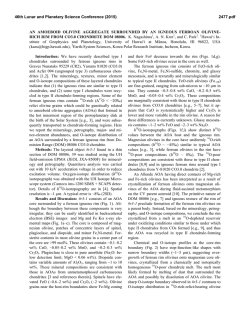
NORTHWEST AFRICA 8535: UNIQUE DUNITIC ANGRITE. C.B.
46th Lunar and Planetary Science Conference (2015) 2681.pdf NORTHWEST AFRICA 8535: UNIQUE DUNITIC ANGRITE. C.B. Agee, H.M. Miley, K. Ziegler, and M.N. Spilde. Institute of Meteoritics and Department of Earth and Planetary Sciences, University of New Mexico, Albuquerque, NM 87131. Introduction: We report here the discovery of a new type of angrite, NWA 8535, a dunite with approximately 90-95% zoned olivine, which now expands the range of known lithologies for the angrite parent body beyond the current bounds of “volcanic” and “plutonic” types. several larger single crystals up to ~1 cm were observed. The most magnesian olivine core is Fa10.2, the most Fe-rich rim measured is Fa38.8, with the mean value Fa20.6±5.8 (n=148). Because olivine dominates the mineralogy of NWA 8535, the bulk composition is LN WO 40 60 DI 50 50 HD 60 40 70 30 80 20 Olivines Kirschsteinites Fassaites 90 10 100 FO EN 0 0 10 20 30 40 50 60 70 80 90 FA FS 100 Fig 2. Combined olivine and pyroxene quadrilateral showing the olivine, kirschsteinite, and fassaite compositions in NWA 8535. by far the most magnesian and refractory of the angrites. Olivines have a wide range of CaO contents ranging from 0.02-2.49 wt%, positively correlating with Fa-content (figure 2), and also have relatively Dunitic Angrite NWA 8535 0.014 0.010 Mn (afu) 80 n= 0 =9 Mn Fe/ 0 10 n= M / Fe 0.012 Fig. 1. Hand sample, the NWA 8535 main mass, broken surface reveals green olivine crystals and prominent cavity (dark shadow). Physical characteristics: NWA 8535 is a 149gram single stone purchased in Morocco in March 2014. The exterior of the sample is slightly weathered retaining patches of black fusion crust, coarse green olivine crystals up to several millimeters are visible on the surface as well as some smoothed mm-sized vugs. The broken surface that yielded the deposit sample revealed a fresh, bright green, polycrystalline texture with a prominent cavity -- presumably a vug or large vesicle (figure 1). Mineralogy & Petrology: Electron microprobe examination of several polished mounts shows approximately 90-95% olivine, ~3% fassaite, ubiquitous aluminous spinel, chromium spinel, troilite, kamacite, taenite, and trace amounts of kirschsteinite -- no plagioclase was detected. Olivines are all zoned with Feenriched rims, many of the grains probed are in the size range of 500-1000 µm, however in hand sample /M Fe 0.008 0.006 0.004 Olivines NWA 8535 0.002 0.2 0.4 0.6 0.8 1.0 1.2 Fe (afu) Fig 3. Fe versus Mn showing the range of values for olivines in NWA 8535. high Cr2O3=0.26±0.18 wt%. Olivines in NWA 8535 have typical angritic values of Fe/Mn=90±7, which was an early diagnostic determined during the reconnaissance and classification phase of this meteorite (figure 3). Fassaite (Al-Ti-bearing diopside), another 46th Lunar and Planetary Science Conference (2015) 2681.pdf common angritic mineral occurs throughout NWA 8535, primarily as small grains (~50-100 µm) along olivine grain boundaries and occupying triple junctions. The mean values of fassaite are Fs12.4±1.7Wo55.3±1.8, Fe/Mn=92±24, Al2O3=12.9 wt%, TiO2=1.9 wt%, n=20 (figure 2). Oxygen Isotopes: NWA 8535 is classified as a angrite meteorite based oxygen isotopes, Fe/Mn of olivine, and presence of fassaite and kirschsteinite. Figure 4 shows our results for laser fluorination analyses of seven acid-washed portions of bulk sample with values of Δ17O= -0.070, -0.138, -0.109, -0.053, -0.069, -0.085, -0.105 (all linearized, permil). All of the measured values fall within the Δ17O range for angrite meteorites, however one sample gave a δ18O value that extends the lower range of angrites by nearly 1‰. Angrite Oxygen Isotopes 17O (‰) 2.0 L TF 1.5 NWA 8535 Dunite Angra dos Reis Plutonic Angrites Volcanic Angrites 2.5 3.0 3.5 4.0 4.5 18O (‰) Fig 4. Triple oxygen isotope diagram showing data from NWA 8535 (red stars) compared to other angrite meteorites [1]. TFL=terrestrial fractionation line. Discussion: NWA 8535 expands the range of known lithologies from the angrite parent body, however there remain numerous questions about its origin, formation and genetic relationship to the other angrites. Although NWA 8535 is an ultramafic rock (dunite), it bears little textural resemblance to the socalled plutonic angrites, in that its olivines are strongly zoned (figure 5), suggesting rapid cooling during formation. Therefore, it is possible that NWA 8535 has a more direct link to the so-called volcanic angrites, most of which appear to be rapidly cooled basalts. Interestingly, the proposed “xenocrystic” olivines in volcanic angrites Asuka 881371 and D’Orbigny [1] overlap in composition with the olivines in NWA 8535, however further work is needed to establish any genetic relationship to these meteorites. Future work will also include age-dating, trace element and isotopic studies, magnetics, and the nature of the vugs and numerous vesicle-like inclusions in NWA 8535. Fig 5. An example of a NWA 8535 deposit sample probe mount used in this study. Top image is a false color magnesium map, bottom is the same image in BSE, scale bar 5000 microns. References: [1] Keil K. (2012) Chemie der Erde, 72, 191–218 (and referenced conference abstracts therein).
© Copyright 2024

